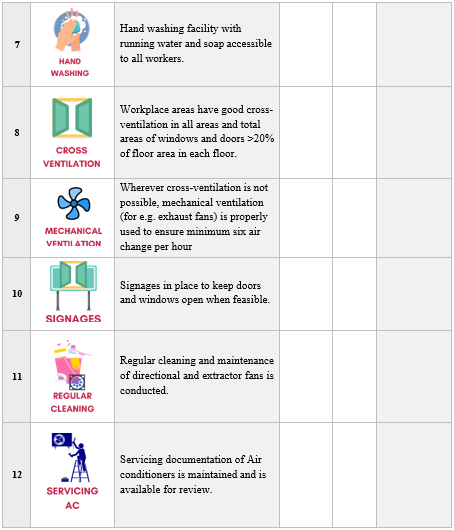Guidance Note on Establishing TB Free Workplaces
Guidance Note on Establishing TB Free Workplaces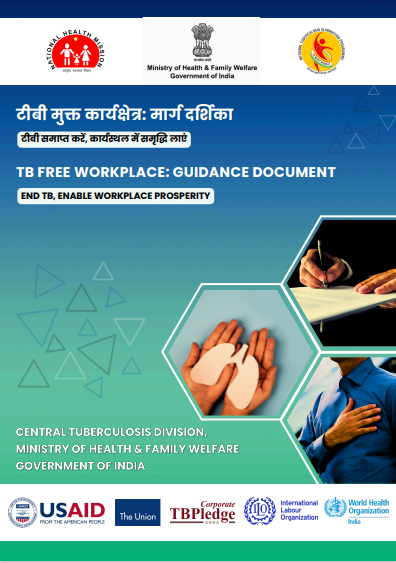

‘Guidance note on establishing a TB Free Workplace’ has been prepared by Central TB Division (CTD), MoHFW, GoI under the guidance of Ms. L. S. Changsan, Additional Secretary and Mission Director, National Health Mission (NHM), MoHFW, GoI and Dr.K.K. Tripathy, Economic Advisor (NTEP). The work on this entire document was well supported and guided by Dr. Rajendra P. Joshi-DDG (TB), CTD, MoHFW, GoI.
Our sincere thanks to Dr. Sanjay Kumar Mattoo, Joint Commissioner and Addl. DDG (TB) for his leadership and spearheading this initiative. We appreciate Dr. Alok Mathur Addl. DDG (TB), Dr. Veena Dhawan Addl. Commissioner (TB), Dr. Raghuram Rao (ADG-TB) and Dr. Nishant Kumar (Joint Director-Public Health) for their valuable inputs and constant support. We would also like to extend gratitude to Dr. Reuben Swamickan (Deputy Director, USAID India), Dr. Ranjani Ramchandran (NPO-WHO), Mr. Syed Mohammad Afsar (Senior Technical Specialist, International Labour Organization), and Dr. Jyoti Jaju (Project Director - iDEFEAT TB Project, The Union) for their expert guidance and whole-hearted support to this initiative. Learnings from workplace interventions by the ILO, various organizations and corporates through the GoI’s and USAID’s Corporate TB Pledge initiative are incorporated in the guidance note.
The writing group consists of: Dr Sanjay Kumar Mattoo, Dr Mrigen Deka, Ashish Verma (Central TB Division), Dr Shibu Balakrishnan (WHO India), Dr. Bhavin Vadera (USAID), Mohd Shadab, Tripti Agarwal, Shreeja Nair, Dr Nidhi Sumnyan, Dr Manu Mathew, and Dr Rakesh PS (The Union).
AIC Air-borne Infection Control
CSR Corporate Social Responsibility
CTD Central Tuberculosis Division
CTP Corporate TB Pledge
DTC District Tuberculosis Centre
DTO District Tuberculosis Officer
DTC District Tuberculosis Cell
ELM Employer Led Model
HIV Human Immunodeficiency Virus
IEC Information, Education and Communication
ILO International Labour Organization
LTBI Latent Tuberculosis Infection
MOLE Ministry of Labour & Employment
MoU Memorandum of Understanding
MoHFW Ministry of Health & Family Welfare
NCEUS National Commission for Enterprises in the Unorganized Sector
NGO Non-Government Organization
NTEP National Tuberculosis Elimination Programme
OSH Occupational Safety and Health
PHI Peripheral Health Institute
PSU Public Sector Undertakings
PSE Public Sector Enterprises
STC State Tuberculosis Cell
STO State Tuberculosis Officer
TPT Tuberculosis Preventive Treatment
TB Tuberculosis
The Union International Union Against Tuberculosis and Lung Disease
USAID U.S. Agency for International Development
WHO World Health Organization
Any workplace can self-declare to be a ‘TB Free Workplace’ based on the check-list provided in Annexure 7.3. The workplace committee can conduct an assessment to review the interventions and align them with the check-list. Once verified, the management can declare their workplace as a TB Free Workplace setting. The self-declaration of being a TB Free Workplace needs to be renewed by the workplace management every year.
Technical support for establishing a TB Free Workplace will be provided by:
• Central TB Division (CTD), Ministry of Health & Family Welfare, GoI. https://tbcindia.gov.in/
• National TB Elimination Programme (NTEP) – Concerned State TB Cell & District TB Centre
DTO Directory: https://reports.nikshay.in/Reports/DtosDirectory
STO Directory: https://reports.nikshay.in/Reports/StosDirectory
• Corporate TB Pledge (CTP) Secretariat, The Union – ttechnical support to corporate organizations for designing and implementing TB related activities and projects.
For further information, kindly visit: www.corporatetbpledge.org
Air-borne Infection Control (AIC): Air-borne Infection Control (AIC) measures are a set of practices that minimizes the spread of airborne transmission of infections. These precautions are generic for all airborne infections, but they also contribute to reduce the spread of TB.
Corporate TB Pledge: The Corporate TB Pledge (CTP) is a joint initiative of Ministry of Health and Family Welfare, Government of India and US Agency for International Development (USAID) with an objective of galvanizing corporates to jointly work towards a shared vision of eliminating TB from the country.
Discrimination: As referred to in the ILO Convention No. 111, discrimination is defined as any distinction, exclusion or preference which has the effect of nullifying or impairing equality of opportunity or treatment in employment and occupation.
Formal Sector: The formal (organized) sector includes primarily those establishments which are covered by the Factories Act, 1948, the Shops and Commercial Establishments Acts of State Governments, the Industrial Employment Standing Orders Act, 1946 etc. This sector already has a structure through which social security benefits are extended to workers covered under these legislations.1
Industry: “Industry” means any business, trade, undertaking, manufacture or calling of employers and includes any calling, service, employment, handicraft, or industrial occupation or avocation of workman.2
Informal Sector: The informal sector, also known as the unorganized sector, consists of all unincorporated private enterprises owned by individuals or households engaged in the sale and production of goods and services operated on a proprietary or partnership basis and with less than ten total workers.3
Organization: An organization is an entity such as a company, an institution, or an association comprising of one or more people and having a particular purpose. There are a variety of legal types of organizations, including corporations, governmental and non-governmental organizations, political organizations, international organizations, armed forces, charities, not- for-profit corporations, partnerships, cooperatives, and educational institutions, etc. The organization may have either/both permanent and contractual workers.
Presumptive TB: Individuals with presumptive TB are those with signs or symptoms suggestive of TB disease and where further diagnostic workup including bacteriological investigation is required.
Peripheral Health Institute: A Peripheral Health Institute (PHI) is a health facility under the National TB Elimination Program (NTEP), manned by at least a Medical Officer (MO), where diagnosis and management of TB are done. It can be a public or private health facility.
Private Sector: The private sector or enterprise refers to the businesses that are owned by a private group or an individual.
Public Sector Undertakings (PSUs): Public Sector Undertaking (PSU) means any corporation established by or under any Central, State or Provincial Act, which is owned, controlled or managed by the Government.
Reasonable accommodation: Any modification or adjustment to a job or to the workplace that is reasonably practicable and enables a person having TB to have access to, or participate or advance in, employment.
Stigma: Stigma is described as a phenomenon whereby an individual with an attribute that is deeply discredited by her/his society is rejected as a result of that attribute. It is a process by which the reaction of others spoils normal identity, and which disqualifies the individual from full social acceptance4
Workplace Policy for Ending TB: Workplace Policy for ending TB refers to the document published by State Government/ institution/ enterprises in sync with national policy document ‘Policy Framework to address Tuberculosis, TB related co-morbidities and HIV in the World of Work in India.
TB Free Workplace: A TB Free Workplace is defined as a workplace where systems are implemented to protect the workforce from TB and sufferings due to TB and it includes provisions for-
- Ensuring a stigma and discrimination-free environment for all workers affected with TB
- Generating awareness about TB among all workers
- Promoting early & complete diagnosis of TB among the workers
- Supporting correct & complete treatment for all workers affected with TB, while respecting confidentiality of their medical information.
- Connecting workers affected with TB to social protection/welfare schemes and other public health measures for a comprehensive care
- Providing nutritional support to all workers undergoing treatment for TB
- Preventing transmission of TB in the workplace
- Ensuring reasonable accommodation for all workers affected with TB to enable them to participate or advance in employment.
TPT: Tuberculosis Preventive Treatment (TPT) consists of a course of one or more anti- tuberculosis medicines given with the intention of preventing the development of TB disease. TPT is given to people who are infected with TB bacteria or have been exposed to it but presently do not have an active TB disease.
Worker: Worker refers to any person working under any form or arrangement. An employee, a contractual worker etc. can all be referred as workers.
Workplace: Workplace refers to any place in which workers perform their activity.
References:
1 The Factories Act, 1948.
2 Section 2(j) of the Industrial Disputes Act, 1947
3 National Commission for Enterprises in the Unorganized Sector (NCEUS).
4 Strategy to End Stigma & Discrimination Associated with Tuberculosis, NTEP. Central TB Division, MoHFW, GOI. 2021
An estimated 10.6 million people fell ill with Tuberculosis (TB) globally in 20225. India carries an estimated 27% of the global TB incidence with an estimated 28.2 lakh people contacting the disease and approximately 3.4 lakh people succumbing to the disease every year. The surveillance efforts in India marked a milestone year in 2022, with a record high notification of 24.2 lakh cases.6
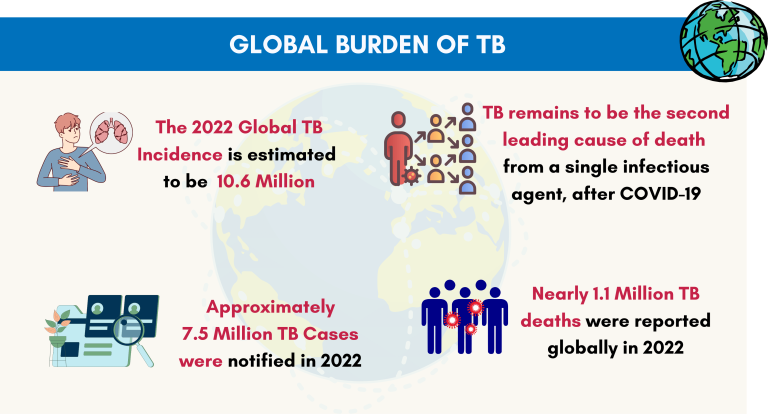
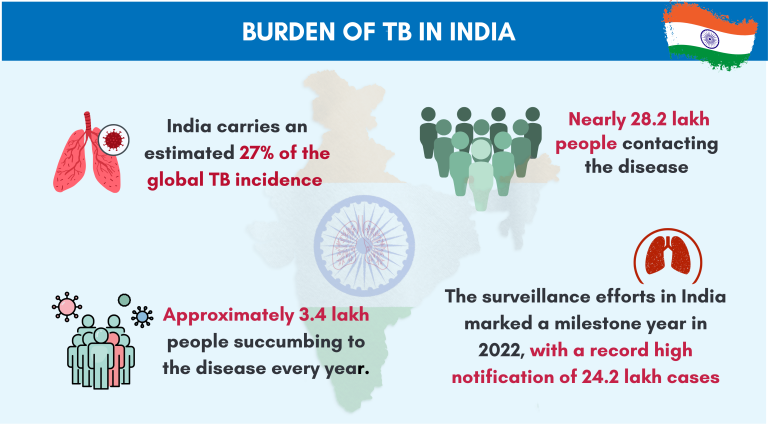
The National Multisectoral Action Framework for TB-Free India, which aimed at building partnerships for convergent actions for a holistic response to TB epidemic, has identified ‘TB Free Workplace’ as one of the six strategic areas for multisectoral action. Engagement of workplace settings towards a ‘TB Free Workplace’ is an effort to complement government initiatives for ending TB among the working population engaged in various occupational settings (formal and informal) through strategic interventions at workplaces.
Government of India has developed and released a ‘Policy Framework to address Tuberculosis, TB related co-morbidities and HIV in the World of Work in India’ in 2019. The overall goal of this policy framework is to provide an operational framework to all stakeholders in the world of work towards the goal of ending TB by 2025.
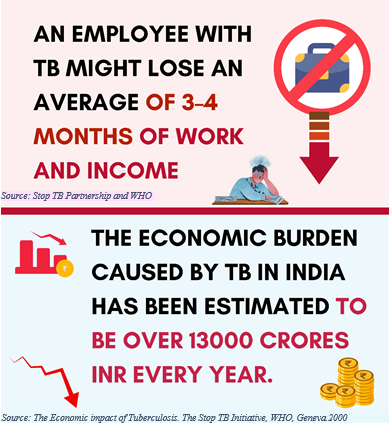
References:
5 Global TB Report 2023
6 India TB Report 2023
The economic burden of TB in terms of loss of lives, income and workdays is substantial. TB usually affects the most economically productive age group of society resulting in a significant loss of working days and pushing people with TB further into the vortex of poverty due to catastrophic costs. India has more than 500 million workers, majority of whom work in unorganized sector with no or limited access to healthcare and social security. A worker with TB might lose an average of 3–4 months of work and income, resulting in potential losses of 20-30% of their annual household income. The economic burden caused by TB in India has been estimated to be over 13000 crores INR every year.7,8
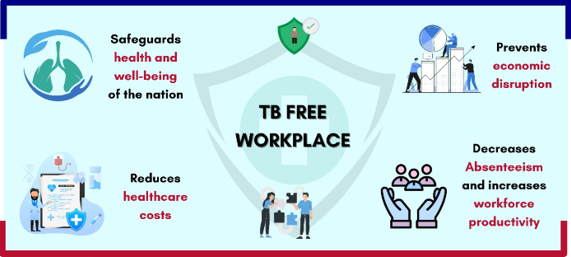
The world of work can play a critical role in ending TB in India. TB epidemic leads to substantial economic repercussions for both individuals and organizations due to lost productivity, worker absenteeism and employee turnover. Employers need to assume an accountability to adopt and implement a TB Free Workplace intervention. A healthy workforce results in higher productivity making supportive workplace policies mutually beneficial for the industry and its employees. A successful and innovative TB Free Workplace model implemented by any organization, puts them in the forefront of the nation’s movement to end TB.
References:
7 Research for Action: Understanding and controlling TB in India. SEARO, WHO, New Delhi, 2000
8 The Economic impact of Tuberculosis. The Stop TB Initiative, WHO, Geneva, 2000
A TB Free Workplace is defined as a workplace where systems are implemented to protect the workforce from TB and sufferings due to TB and it includes provisions for –
-Ensuring a stigma and discrimination-free environment for all workers affected with TB
-Generating awareness about TB among all workers
-Early & complete diagnosis of TB among the workers
-Supporting correct & complete treatment for all workers affected with TB, while respecting confidentiality of their medical information.
-Connecting workers affected with TB to social protection/welfare schemes and other public health -measures for a comprehensive care
-Providing nutritional support to all workers undergoing treatment for TB
-Preventing transmission of TB in the workplace
-Ensuring reasonable accommodation for all workers affected with TB to enable them participate or advance in employment.
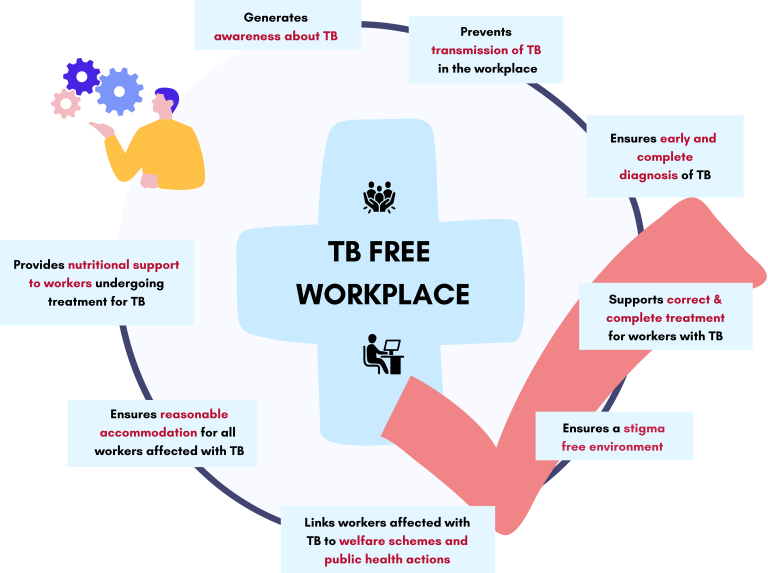
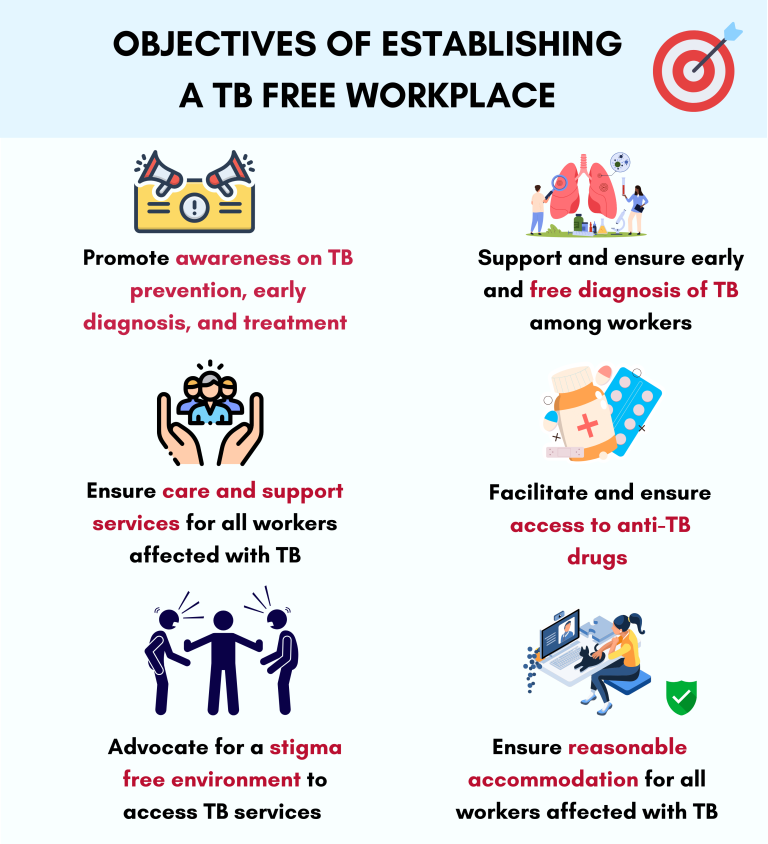
To establish a TB Free Workplace, it is essential for the senior management of any organization to first be sensitized on TB and its burden. Subsequently, make a commitment to create an environment with certain provisions where all their workers, including contractual workers: (a) have easy access to information and services on TB and workers feel confident to utilize these services; (b) have an environment conducive for prevention of TB; (c) encourage periodic screening for active TB with utmost regard for maintaining worker confidentiality; (d) workers having active TB are identified early and are put on complete treatment; (e) linked to appropriate social protection/welfare schemes and other government schemes; (f) are provided nutritional support during treatment; (g) receive leave benefits and employment protection; and (h) are not discriminated either based on real or perceived TB status. The organization can take the support of government health system and/or suitable NGOs to implement TB related activities in the workplace.
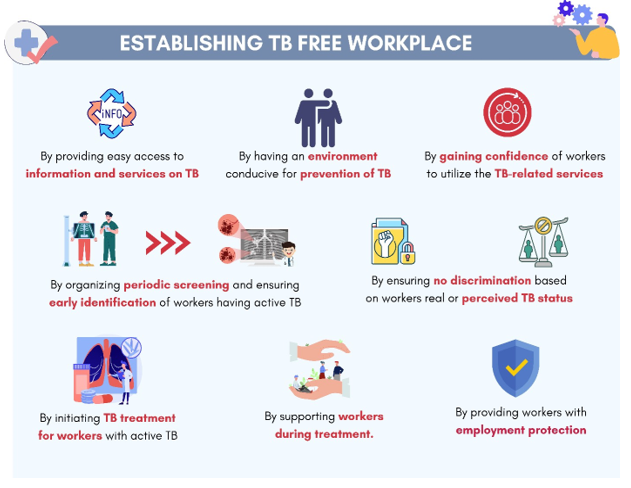

Employers need to demonstrate their commitment to adopt and implement a TB Free Workplace intervention. Any workplace committed to becoming a TB free workplace will have a policy/guidelines ensuring their commitment to non-discrimination on grounds of real or perceived TB status; awareness generation; prevention of TB transmission; early diagnosis; treatment initiation; support for completion of treatment; and continuation of employment relationship irrespective of the disease status. Model organization’s workplace policy is attached as Annexure7.1.

While the overall accountability of adopting and implementing the workplace policy rests with the management (Director Board/Chief Executive Officer/Managing Director), for day-to-day co-ordination and implementation of activities, it is desirable to have a workplace committee in place. TB free workplace committee needs to be established with clear terms of reference (Model ToR Annexure 7.2).
The committee needs to: -
- Prepare annual action plan related to workplace intervention for ending TB.
- Mobilize resources, including identification of volunteers, for implementation of action plan.
- Implement the interventions as per the action plan
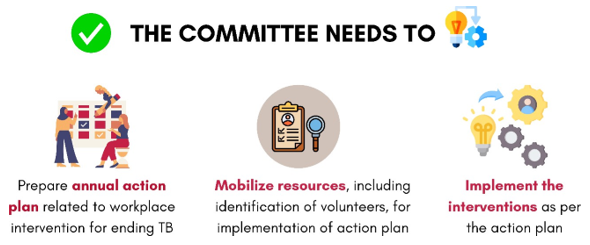
For smaller workplaces (Up to 100 workers), if it’s difficult to establish a committee, a nodal person from the organization may be nominated to oversee planning and implementation of workplace intervention on TB. (Customise the ToR for the nodal person based on Annexure 7.2)

Peer educators are the selected workers among the workforce who, after getting trained, play a key role in the implementation of the TB programme in their workplace. They are expected to provide awareness, screening and treatment support to the workers in need. Ideally one peer educator should be there for 50 workers.
A Peer Educator should:
- be literate with formal education up to Eighth class (preferable)
- have effective communication skills & leadership qualities
- be accepted by their peers in the workplace
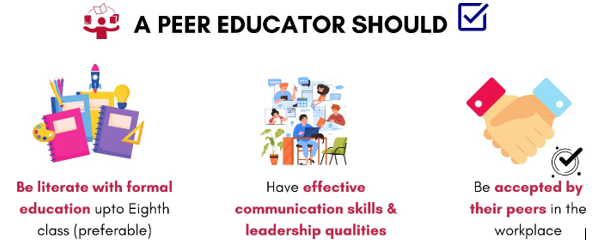
All peer educators need to undergo four hours of ‘Course for health volunteer and treatment supporters in NTEP’, endorsed by Central TB Division, and obtain their certificates. Peer educators engaged in other health and wellness activities at workplaces like in occupational safety and health, HIV programmes etc. can also be trained and engaged. In a workplace with a health facility, the health staff can be further equipped to become trainers for training the peer educators.

The entire workforce needs to be sensitized on the organization’s commitment to make the workplace TB Free and policy/guidelines related to it.
Awareness Messages need to focus on:
a) Organisation’s commitment to End TB in the workplace
b) Cough etiquettes and respiratory hygiene to be followed to prevent TB and other respiratory infections.
c) Symptoms and diagnosis of TB
d) Facilities for diagnosis and treatment of TB
e) Government Schemes available for workers affected with TB
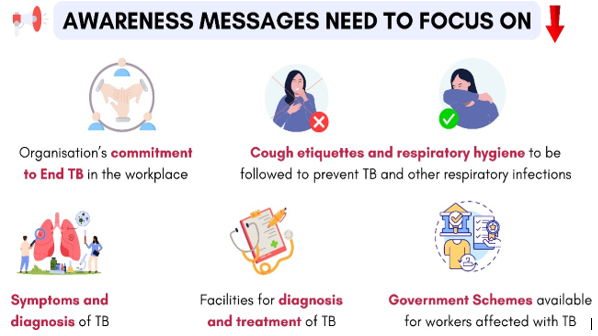
Information Education Communication (IEC) activities for awareness generation could be done through posters on TB at strategic locations, health talks on TB, periodic health & wellness sessions, broadcasting messages on TB through internal Audio-Visual systems and propagating messages through social media groups.

Proper Branding of workplace interventions for ending TB will have significant impact in mobilisation of workers towards adopting healthy behaviours. This can include adopting an overarching theme such as ‘Ending TB: We are working towards it!
The TB Free Workplace theme may be adapted by workplaces themselves through consultations and then displayed in strategic locations of the workplace to inspire action and implementation of the workplan.

The management needs to establish linkages with health facilities/NGOs or equip their own health/ OSH facilities to provide the entire spectrum of TB services including testing and treatment. This could also be done in partnership with the local NTEP networks.

Regular screening can be conducted either by asking the workers for symptoms suggestive of TB or by taking a Chest X-ray. Anyone having any of the major TB symptoms (persistent cough for 2 weeks or more, evening rise of temperature/fever for 2 weeks or more, unexplained weight loss, complete loss of appetite, blood in sputum, night sweat & fatigue) or visible abnormalities in the Chest X-ray will be identified as workers with presumed TB. In case of occupations like mining, textile, construction, glass etc. TB screening may be done once in every quarter.
Organizations can also promote self-screening among the workers through TB Arogya Sathi Application.(https://play.google.com/store/apps/details?id=com.tb.aarogya.sathi&pcam… d=web_share)
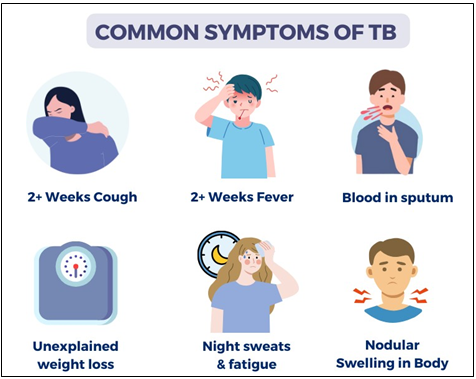

Post screening, ensure all workers with presumptive TB are evaluated for TB. A systematic specimen collection and transportation process may be established so that specimen collected from all workers with presumed TB reaches the nearest TB detection centre for further investigations and evaluation.

It has to be ensured that all workers diagnosed with TB are promptly put on treatment at the organization health facility of the workplace or linked to the nearest NTEP health facility.
Details are available in the link: https://reports.nikshay.in/Reports/PhiDirectory

Treatment support consists of counselling, adherence support, nutrition support, psychological support, welfare schemes for workers, and linking with other social protection schemes etc. Additional customised support for the workers such as support for transportation, support for air borne infection control kits etc. may also be provided by the management. This can also be done with the support of National TB Elimination Programme.
The Ministry of Health & Family Welfare, through Central TB Division, has introduced the ‘Pradhan Mantri TB Mukt Bharat Abhiyaan’ (PMTBMBA) campaign where the community is encouraged to adopt people affected with TB and support them in the form of nutritional support, nutritional supplements, additional investigations, and vocational support for a minimum period of six months or maximum period of up to three years. Workplaces are encouraged to identify Nikshay Mitras to support their workers affected with TB.
The details of PMTBMBA & the support provisioned under this are available in the link below: https://communitysupport.nikshay.in/

Management may take possible steps to provide reasonable accommodation to workers affected with TB from the loss of job/wages. This may include leave or temporary change in allotted duties to continue treatment or others as situation demands. Based on advice of the medical doctor, the worker may be encouraged to resume work once they become non-infective of TB.

Since TB is an air-borne disease, workplaces need to follow measures to control the transmission of TB among the workers. Risk assessment of workplaces may be conducted every year by a medical/nursing professional using the checklist for Air-borne Infection Control in workplaces in Annexure 7.6. Compliance to the recommendations in the assessment report needs to be ensured by the committee.

Monitoring of the activities against the annual plan need to be done routinely by the management. It has to be ensured that the information of workers diagnosed with TB is updated on a real time basis in Ni-kshay, the management information system of NTEP. It is also a good practice to publish a one-page annual report regarding the TB status and efforts to end TB in the workplace.
Monitoring indicators for workplace TB intervention:
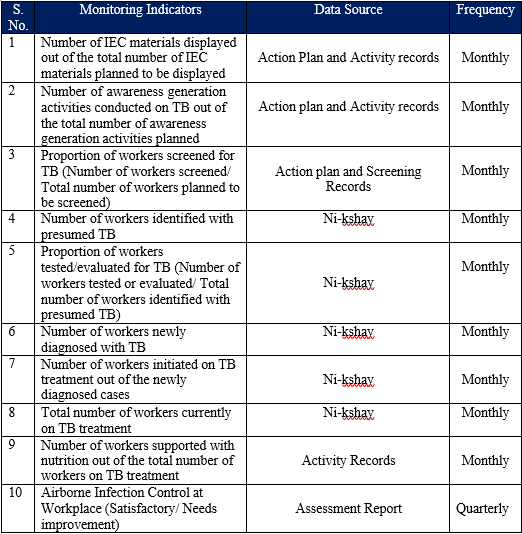
Any workplace management can self-declare to be a ‘TB Free Workplace’ based on the check- list provided in Annexure 7.3. The workplace committee can conduct an assessment to review all the interventions and align them with the check-list. Once verified, the management can declare their workplace as a TB Free Workplace setting. This does not mean that there is no TB in the workplace, this means that the workplace has implemented all the interventions to end TB and sufferings due to TB in their workplace. The self-declaration may be valid for a time period of one year and can be renewed by the workplace committee under the same process.
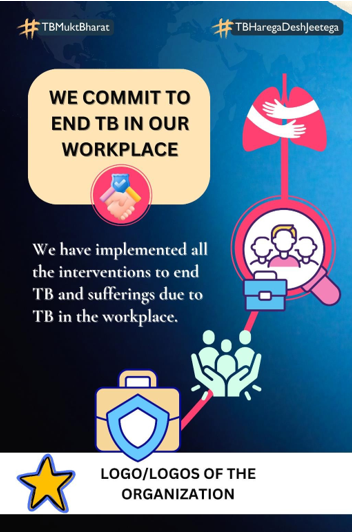
Once the aforementioned process is completed, the organization may inform this to the District TB Center. The District TB Officer or their representative (MOTC, MO-PHI) can review and certify the organization to have moved ‘Towards a TB Free Workplace’.
The role of State TB office is to maintain a district-wise database of organizations that have been certified on moving towards a TB Free Workplace. The Certification (see below) needs to be properly displayed at a prominent location in the workplace.
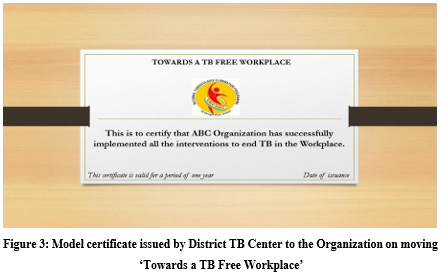
Technical support for establishing a TB Free Workplace will be provided by:
- Central TB Division (CTD), Ministry of Health & Family Welfare, GoI. https://tbcindia.gov.in/
- National TB Elimination Programme (NTEP) – Concerned State TB Cell & District TB Centre. For further information on the State and District TB centres, kindly visit the links to the directory of District TB Officer and State TB Officer respectively:
DTO Directory: https://reports.nikshay.in/Reports/DtosDirectory
STO Directory: https://reports.nikshay.in/Reports/StosDirectory
The brief roles of ‘NTEP’ at state and district with regard to Workplace Intervention has been briefly mentioned in Annexure 7.4
- Corporate TB Pledge (CTP) Secretariat, The Union – technical support to corporate organizations for designing and implementing TB related activities and projects.
For further information, kindly visit: www.corporatetbpledge.org
Several guidelines and resources developed by Central TB Division and partner organizations are extremely useful for reference:
- Guidance Document on Partnership 2019, CTD, MoHFW. (https://tbcindia.gov.in/WriteReadData/l892s/9531588006Guidance%20Doucum…% 20on%20Partnerships%20RNTCP%202019.pdf)
- Policy Framework to address Tuberculosis, TB related co-morbidities and HIV in the World of Work in India, MoLE, GOI. (https://labour.gov.in/sites/default/files/framework.pdf)
- A Resource Manual for Peer Educators of Enterprises on TB and HIV/AIDS Workplace Programmes.
( Resource Manual for Peer Educators of Enterprises on TB and HIV/AIDS Workplace Programmes (ilo.org) )
- Employer Led Model for Tuberculosis Prevention and Care, CTD, MoHFW. (https://tbcindia.gov.in/WriteReadData/Reach%20ELM%20Operational%20Manua… df)
- National Multi sectoral action framework for TB Free India. (https://tbcindia.gov.in/WriteReadData/l892s/57479351National%20Multisec… 0Action%20Framework%20for%20TB-Free%20India_30-8-19.pdf)
- Statement of Commitment of India Employer Organizations on addressing TB and HIV in the World of Work
(https://www.ilo.org/wcmsp5/groups/public/---asia/---ro-bangkok/---sro- new_delhi/documents/publication/wcms_744694.pdf)
- National Framework for a Gender Responsive Approach to TB in India (https://tbcindia.gov.in/showfile.php?lid=3496)
- Standards for TB Care in India (https://tbcindia.gov.in/showfile.php?lid=3061)
- Training Curriculum for Peer Educators
Course for Health Volunteers and Treatment Supporters in NTEP | Knowledge Base
- Guidelines on Airborne Infection Control in Healthcare and other settings https://tbcindia.gov.in/WriteReadData/l892s/4830321476Guidelines_on_Air… ection_Control_April2010Provisional.pdf
- India TB Report 2023, CTD, MoHFW, Govt. of India. (https://tbcindia.gov.in/WriteReadData/l892s/5646719104TB%20AR-2023_23
%2003-2023_LRP.pdf)
- Global Tuberculosis report 2023, WHO (https://www.who.int/publications/i/item/9789240083851)
- IEC materials on TB (https://tbcindia.gov.in/index1.php?lang=1&level=1&sublinkid=4837&lid=31…)
MODEL ORGANIZATION’S WORKPLACE POLICY FOR ENDING TB:
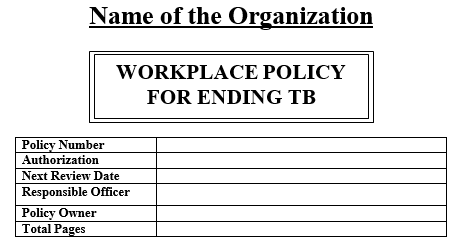
INTRODUCTION
In 2022, an estimated 10.6 million people fell ill with TB globally. India carries an estimated 27% of the global TB incidence with an estimated 28.2 lakh people contracting the disease and approximately 3.4 people succumbing to the disease every year. TB is known to cause a decline in workers’ productivity on the order of $13 billion every year.
It has become essential to create a work environment where TB is addressed and provision of TB services for the workers is made available. A healthy workforce results in higher productivity, making supportive workplace policies mutually beneficial for the industry and its employees. Institutional policies for TB can play a pivotal role in spreading awareness, creating a culture of support and inclusion and helping in the prevention and spread of TB. Every organization assume an accountability to adopt and implement a policy to end TB in their workplace. The following points outline the main pillars that set the standard for TB care at the workplace.
A brief introduction of the organization A short paragraph about the organization,
capturing its workforce and mission/values particularly with regards to health and wellness of employees. The organization has a role to play in contributing to a TB-Free India………………………
Scope of the policy: …………….…(Mention who all are covered in the policy) …………….……….
ORGANISATION’S POLICY
- The organization will treat TB as a workplace issue because it affects the health of workers and the productivity of the organization.
- The organization will not discriminate against workers based on known or presumed status of Tuberculosis. No one should experience discrimination on the basis of their TB status, whether in terms of continuing employment relationships or access to health insurance, occupational safety, and health care schemes.
- The organization will not ask job applicants or employees to disclose information whether they have TB or not. Access to personal data about health status of employees, including about TB will be kept confidential.
- Organization shall foster a culture of care towards workers who are afflicted with Tuberculosis.
- Prevention of TB will be a key priority. Continuous efforts will be made to make workers aware of symptoms of Tuberculosis, and the importance of early diagnosis and treatment
- Employees will be encouraged to seek voluntary TB screening, including self-screening
- Air-borne Infection Control measures will be promoted to prevent transmission of Tuberculosis among the workers.
- Counselling services will be ensured for workers and their family members seeking help on issues related to Tuberculosis.
- Support for treatment adherence and completion will be provided to all workers affected with TB.
- Provision of nutritional support to all workers undergoing treatment for TB.
- Employees with TB should be entitled to work for as long as they are medically fit and appropriate work is available. Reasonable accommodation will be provided to workers affected with TB to enable them to keep their jobs. This may include leave or temporary change in allotted duties to continue treatment or others until the situation demands.
- Information of all workers’ data diagnosed with TB will be updated in Ni-kshay.
Date:
Approved by:
MODEL TOR FOR TB FREE WORKPLACE COMMITTEE:
TB Free Workplace Committee
Name of the Organization……………...
The economic burden of TB in terms of loss of lives, income and workdays is substantial. A large section of the population affected by TB also belong to the economically productive age group that results in a significant loss of working days, pushing people with TB further into the vortex of poverty due to catastrophic costs. Therefore, it is essential to create a work environment where TB is addressed and provision of TB services for the workers is made available. Every organization assumes an accountability to adopt and implement a policy to end TB in their workplace. Ongoing efforts are required to engage different departments and individuals for diversified representation. A workplace committee is formed to ensure proper planning, implementation, and monitoring of TB interventions in the workplace.
I. The Purpose of TB Free Workplace Committee
The TB Free workplace committee will help the management in planning and implementation of TB and workplace activities. The Committee will ensure equitable and gender sensitive approach to the implementation of TB prevention, treatment and care activities in the workplace.
II. Proposed Composition of TB Free Workplace Committee
The Committee would have representative from senior management as chair. Other members include representatives from Human Resource Department, Medical/OSH Unit, CSR wing, Welfare Department and representatives of workers. A person cured from TB/TB Champion may also be included in the committee. Additionally, committee’s gender balance may be maintained.
III. Roles & Responsibilities of the Committee
TB Free Workplace Committee would
1. Initiate and strengthen organization’s response to TB in the workplace.
2. Draft organization’s workplace policy/guidelines on ending TB.
3. Develop annual action plan and mobilize support including required resources for implementation
4. Organize TB awareness activities at/around the workplace premises
5. Address negative attitudes towards people with TB and increase awareness among the workers regarding TB
6. Ensure availability and display of relevant IEC materials at strategic locations across the workplace premises.
7. Ensure every health facility associated with ABC Organization has a Ni-kshay ID and every TB case detected in the organization to be enrolled in Ni-kshay Portal.
8. Facilitate linkage with the government’s social protection schemes so that the workers, particularly the contractual workers may avail the benefits.
9. Conduct periodic TB screening and ensure all workers with presumed TB are tested/evaluated.
10. Develop linkages with public or private diagnostic centres for referral of workers with presumed TB.
11. Ensure that list of local testing and treatment services for TB in Government and private sector is made available to all workers and their families.
12. Develop a mechanism to monitor the implementation of the policy/guidelines and activities for ending TB.
13. Document and disseminate good practices and learnings.
14. Publish a one-page annual report regarding the TB status and efforts to end TB in the workplace.
IV. Frequency of meetings
The committee may meet once in a quarter.
The minutes of the meetings need to be maintained.
Date:
Head of Management,
Name of the Organization……………
Suggested activity and monitoring framework for workplace response to becoming a ‘TB Free Workplace’:
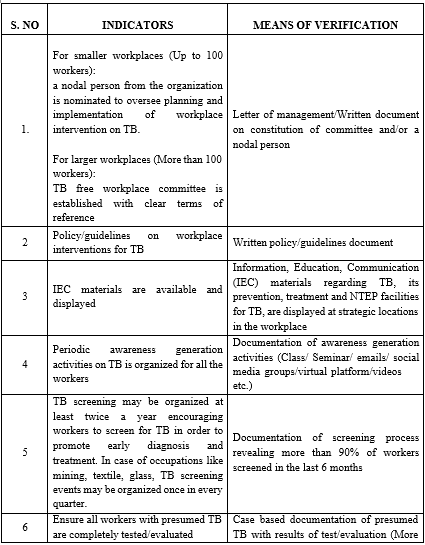
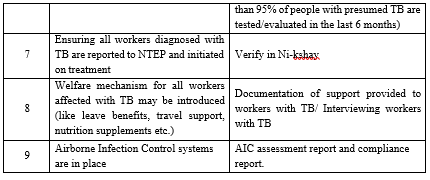
State and District TB Cells play a crucial role in engaging workplaces to establish a TB free workplace setting. Their role includes:
- Mapping of key industries and leading business association/s in the state and districts respectively.
- States may develop a ‘State TB Workplace Policy’ in alignment with National Strategic Plan (NSP) and National Policy Framework to address TB and TB related co-morbidities in the world of work.
- Garnering political and administrative support for collaborating with different workplaces to initiate workplace intervention for TB.
- Developing state and district specific road-map or work plan for an intensified approach to influence different workplaces to adopt interventions for establishing a TB Free Workplace.
- Organize state and district level sensitization meetings and training programme for nodal officers of corporates for partnership for collaborative action.
- Providing technical support to engage workplaces in the TB space
- Supporting capacity building of management, workplace committee, peer educators, and health staff of workplace.
- Ensuring provisions for TB evaluation/testing, treatment initiation, and public health actions for the workers in collaboration with the workplace committee.
- Developing IEC materials and organize awareness generation activities on TB in the workplaces.
- States can develop checklist, reporting system, conduct programmatic review meetings to get update from Districts on corporate response on TB, conduct regular review meeting, field visit to corporates.
- District to conduct assessment and verify a corporate’s claim on being a TB Free Workplace.
- The State TB office to maintain a district-wise database of certified TB Free Workplaces.
- Documenting and disseminating best practices on workplace interventions for TB.
- Facilitate selected industries for outstanding contribution on TB intervention.
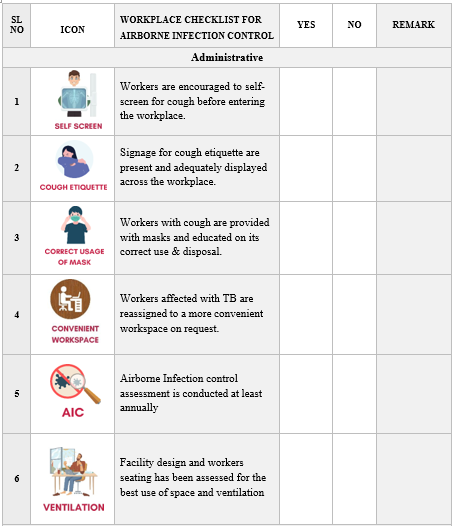
Environmental:
